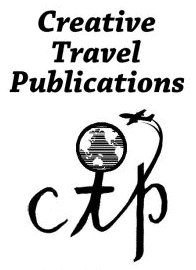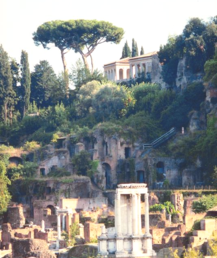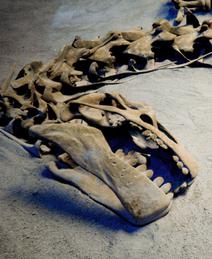Copyright 2017 Creative Travel Publications, LLC
Women's Travel Abroad
For Women About Women By Women
Blog
You Are Welcome to Contact Me Personally With Comments or Questions
Readers: Adults
Period: Paleolithic
Genre: Fiction/Novel
History/Europe
Extras: Map
List of Characters
Earthmaker's Symbols
Moon Months
Contents
Drawings
Epilogue
Bibliography
The Light at the End of the World
A Story of Spiritual Transformation in a Time of Catastrophic Change
Lorraine Dopson
Angel Fire Press, Bismark, 2002. ISBN: 0971212309
This is one of the most astonishing novels about prehistory I have ever read. Dr. Loraine Dopson appears to have used her knowledge of science and her professional experience as a psychologist to create a fascinating and believable story. Her characters have depth of character and distinctive personality.
Recent scientific research suggests that sometime during the end of the Pleistocene, around 9,600 B.C., an immense asteroid may have hit the earth. Geological evidence suggests the crash may have caused major climatic changes. If this hypothesis is true then humans of this era would have faced enormous challenges for their very survival.
In this novel Dopson focuses on the emotional aspects of such a this cataclysmic event. She endeavors to accurately write about life during this period and also seems to capture the full traumatic effect, physical and emotional, of this impending event on the people in her story.
Perhaps this is because her novel is based on extensive research and reading. In the epilogue Dopson reviews recent findings on the development of the human brain during this period of time. Her bibliography Dopson is filled with a references to books about climatology, neuropsychology, and womens prehistory.
Before even reading this story Dopson supplies us with intriguing and interesting details including an artistically drawn map, a biographical list of all of her characters, and a guide to the visual symbolic language used in the story. Her contents page is divided into three parts. Each part has a description of the story's progression.
The story tells us about Thistle, an endearing young girl of the People of the Mother, and her fellow tribe members increasing awareness of impending doom. They see a large object in the sky surrounded by a bright light appears coming closer and closer to the earth. The wise woman of the tribe cannot explain the phenomenon and their desperate pleas to the powerful Great Mother does not seem to be able to stop it.
So Thistle sets out on a journey to find out if other people are sharing the same experiences about the light in the sky. She learns that tribes are also suffering physically and emotionally. While Thistle ultimately comes to accept it as a time of major upheaval she also realizes the enormity of the change will drastically affect her very survival.
Thistle and all of the people in her world must make decisions about how to adapt to the changes in their future lives. Although the story is set in prehistoric times I believe Dopson wants her contemporary readers to understand catastrophic events still occur today and we must also be prepared to adapt.
In 2016 my primary focus is on the beguine movement. I am traveling to Ghent, Bruge, and Paris to learn first hand about this unique religious women's movement.
In my suitcase this fall will be lots of articles and books about the beguines. Among them will be a non-fiction book (The Wisdom of the Beguines, The Forgotten Story of a Medieval Women's Movement by Laura Swan) and a novel (Sisters Between, A Novel of the Beguines by Molly Connally). Both will be perfect reading for the the five hour round trip bus ride between Paris and Ghent. I am also researching Roman history this year for a trip I am planning in 2017. I have already read quite a few books about Rome and you can read my thoughts about the most recent book briefs on this blog.
For me reading is an ongoing activity. I like to read almost every genre and use what I read as an integral part of planning every trip I take. When I travel my suitcase is often packed with books and articles about where I am going and the theme I am developing.
Over the last few years I have spent a considerable amount of time reading about the prehistory of France and England. Below you will find some of the novels I have read about Paleolithic Europe.
I find them fascinating because although the stories are not real they provide me with a imaginative glimpse into what life may have been like thousands of years ago. The bibliography also has a listing of many of the non-fiction books I have read about prehistory if you like more factual reading.
There are quite a few other book briefs as well about other topics like travel and history. To view more about other books click on:
Even though I try to stay focused on the topics I am researching I must admit every now and then I get seduced and side-tracked by an especially intriguing title so be prepared for a few surprises here and there along the way. Not every book will be in order but I will try my best to keep related readings together. Well, books are calling to me so I must get on with the next chapter in my reading and the next phase of my travel planning...
Transitioning from the prehistoric to Roman period is difficult. In between these two periods is another often overlooked era - the iron age. This is the time when mining flourished in the Celtic Britain, Gaul, and Africa. A variety of metals were unearthed, processed, and made into functional and decorative items.
Iron gradually replaced almost everything previously made of stone. Perhaps the most significant development was the use of a metal blade on wooden ploughs. The hardness of iron meant land could be turned over deeper and faster than ever before leading to a flourishing of agriculture. Iron was also used to create weaponry of all kinds which have historically been used in battles over territory right up to our times.
This is also the time we see silver, gold, and metal alloys being shaped into beautiful sculptures, jewelry, and home decor. Many of the articles made from these metals, particularly those made of gold, were used in religious rituals and became embedded with magical power. Decorative embellishment on jewelry also developed a symbolism imbued with the mystical implications.
The written language during the Iron Age was, for the most part, still based on a collection of signs for actual objects and things that exist in the world. It was not until 3,500 BC an actual alphabet that had symbols to represent phonetic sounds and the semantic meanings was developed in Mesopotamia by the Sumerians.
Sumerian cuniform writing is the very beginning of our written language. Finally humans could express themselves in a way that has stood the test of time. We began writing down our experiences and adventures, thoughts and feelings, real or fantasy on any natural surface we could find - stone, clay, wax, paper, and computer screens.
The written word has become an important way we humans share our world views. So here are some books, fiction and non-fiction, that speak to me about our history. While most of them are written by women there will also be some written by men.
I Am Livia
Phyllis T. Smith
Lake Union Publishing, Seattle, 2014. ISBN - 13: 9781477848821
Written as a journal this author tells Livia Drusila's story entirely from the perspective of the main character. Nonfiction writers have usually portrayed Livia, the wife of Julius Caesar's adopted son Octavian, as immoral, ambitious, and evil. Smith gives us another look at the notorious woman.
She informs us about her status as the well educated patrician daughter married off to a rather boring older man. Both her father and husband planned the assassination of Julius Caesar and paid for it with death or exile. There was, it seems, very little glamour in her young life traveling the Roman world in search of a safe haven for her husband and sons.
The only thrill in Livia's youth and married life is her infatuation with Octavianus which he appears to have also felt. As time goes by the relationship intensifies leading to her amicable divorce from Tiberius Nero and marriage to ' Tavius' as she affectionately calls her new husband. Just three months after her marriage to Octavian a second son believed to be by Tiberius Nero is born. This event caused a scandal among both Roman patricians and citizens but the author assures us it is fine because Livia and Tavia did not consummate their marriage until after the birth.
So love has triumphed! Livia's involvement in Roman politics follows soon after when she realizes her husband is overloaded with administrative work and it is affecting his health. She encourages him to solve conflict in peaceful ways, stimulate the economy through building projects, and ensure all Rome's citizens are working and well fed.
Despite her advice to negotiate for peace Octavian ends up going off to fight wars with Pompey and Mark Anthony so she spends her time taking care of things in Rome while he is away for which she is severely criticized by everyone including her new husband. The two of them become estranged.
However, when Octavian returns to Rome victorious and exhausted they reconcile with considerable ease. She accepts him as her beloved and Caesar. Just another Roman husband who engages in illicit affairs, a man who lives by a double-standard in every aspect of his life, and a ruler who solves conflict with military might.
Of course, it is not as if she has any other choice if Octavian does not want to divorce her. So the author ends this story with Livia looking back on her life not quite certain why she stayed with Tavius but proud to call Caesar Augustus her husband and leading man of Rome.
The author's sympathetic treatment of Livia deserves commendation. However, it seems a little too unrealistic and sentimental to me. I feel Smith's portrayal of Livia Drusila as a victimized but virtuous Roman woman has created a character equally as shallow and one-dimensional as her slanderous ancient Roman critics.
A new novel by Phyliss T. Smith, The Daughter's of the Palatine Hill, about Cleopatra's forgotten daughter Selene and Octavian's infamous daughter Julia is scheduled to be released on February 16th. I put my name is on the request list at the library. The topic fascinates me and I am looking forward to reading another book by this author.
Readers: Adults
Period: Roman
Genre: Fiction/Novel
History/Rome
Extras: Leading Characters
Author's Note
Before Rome became an empire it was a relatively small, insignificant town in Italy. There were many other more powerful cities all over the world. The city of Athens was among the greatest. Roman merchants traveled to Athens to purchase valuable commodities. When they returned to Rome with their goods the traders also brought back stories about this economically rich and culturally vibrant Greek city.
In no time Romans began copying particular aspects of Grecian culture. It is generally believed Romans adopted many of the Greek gods, adapted Greek government, and assimilated Greek art. However, ancient Romans always claimed Greek influence played only a small role in the development of their society. By the time of the Roman Empire that is most likely true. Besides conquest a policy of cultural acceptance seems to have been a successful practice for enlarging the power of Rome.
Readers: Adults
Period: Ancient Roman
Genre: Non-Fiction
History/Europe
Extras: Contents
List of Illustrations
Forward
Time Scale/Line
Introduction
Photographs
Drawaings/Maps
Notes
Works Cited/Index
Index
The First Fossil Hunters
Paleontology in Greek and Roman Times
Adrienne Mayor
Princeton University Press, Princeton, New Jersey, 2000. ISBN: 0691058636
Adrienne Mayor is an independent researcher of classical legends about natural history. Mayor specializes in collecting unclassified passages in Greek and Latin texts, searching for passages she finds meaningful, and relating her findings to modern science. She garners her information from ancient history, classical literature, and the sciences of paleontology, archaeology, and geology.
The authors uncanny ability to synthesize all this information into a cohesive pattern have led her to identify illustrations and stories about prehistoric dinosaurs and humans in Grecian and Roman art and literature. While this idea may be difficult to believe and perhaps controversial her extensive research warrants serious consideration.
Although her research may be controversial I found this book both intriguing and fascinating. No one else has endeavored to undertake such a mammoth task of trying to prove our prehistoric past was documented before modern science. Yet Mayor has found evidence that ancient Greeks and Romans were also entranced by the same dinosaur bones scientists dig up today in every part of the world.
Ancient stories about unusual looking animals motivated her to search for the real origins of the legendary monsters. During a stay in Athens Mayor became obsessed with a story about griffins, animals with bodies like lions and beaks like eagles, who defended gold from intruders. She searched eastern Europe looking for fossil remains that resembled the literary description of a griffon finally locating it in the remains of a Protoceratops skeleton.
Mayor investigates other giant sized animals that loam large in the oral history and visual artifacts of ancient Greeks and Romans. She discovers similarities between descriptions of these animals and the fossil remains of prehistoric pterosaurs and spinosaurs, mammoths and rhinoceros, and even homo sapiens.
While all this may sound a little bit "off the wall" Mayor has worked very hard to track down the facts. Any book published by Princeton University must meet rigorous guidelines by a jury of academicians before it gets to press. So if, like me, you have an interest in prehistorical paleontology and ancient Greek and Roman art recommend this book.
Some people may say that by Roman era women had become invisible. They seem to think Roman women were captives in their homes obligated to weave endless yards of fabric, birth numerous children, and die in oblivion. However, closer scrutiny reveals a very different story.
Women in the Roman Empire worshiped powerful goddesses, served as priestesses in religious rituals, ruled as queens and empresses, became famous scientists and mathematicians, and even practiced medicine. Women also worked, independently or with their husbands, to create successful businesses ensuring the livelihood of all family members.
Certainly, as in our society today, Roman women may not have been equal to men in every aspect of their lives but outstanding women were still recognized and respected. Among many of the Roman women Livia Drusila, the wife of the emperor Augustus, is one of the most controversial.
From the perspective of ancient Roman male historians Livia is devious and deceitful. Sadly, Empress Livia Drusila did not write her own autobiography so we will never really know any other version of her life. So she is still usually portrayed as a bad woman.




